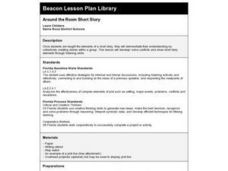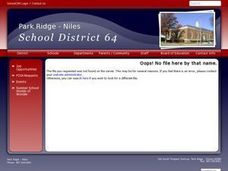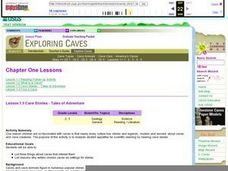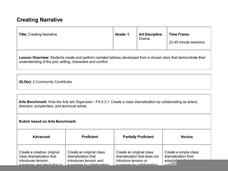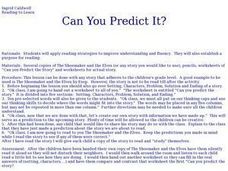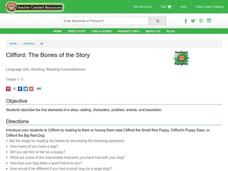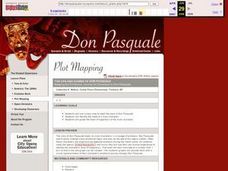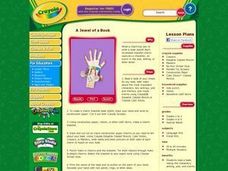Curated OER
Narrative Nuts and Bolts
After viewing slides and reading about child labor, young authors compose an original narrative story. They practice note-taking skills and work to effectively engage a reader by incorporating plot, logical order, complex characters,...
Curated OER
Introduction to Drama
Introduce your class to drama! You cast each pupil as a different character from a story you have read. They are given a general outline of the scene, act out the scene multiple times, then discuss the weak and strong aspects of each...
Curated OER
Around the Room Short Story
Collective story writing is a great way to reinforce the concept of story elements and collaborative learning. Young writers discuss story elements such as, setting, character, action, climax, conclusion, foreshadowing, dialogue, and...
Curated OER
An Author Study on Kevin Henkes
To better understand how the author Kevin Henkes uses the theme of friendship throughout his books, learners engage in several compare and contrast activities. The class reads several Henkes titles and discusses the similarities in...
Curated OER
Lesson Plan 10: Writing Really Good Dialogue
Boring dialogue can run a great story into the ground; get your novelists using dialogue as a tool to move their story into deeper and more developed territory. As part of a larger writing series, this lesson plan has a worksheet that...
Curated OER
Cave Stories - Tales of Adventure
Students list three things about caves that interest them and list reasons why writers choose caves as settings for stories.
Curated OER
Pick A Short Story
Students select a short story and apply various literary elements they have used throughout the year. They deconstruct a short story according to plot, setting, characterization, and theme. Students create a PowerPoint.
Curated OER
Introduction To Literary Analysis
Explore the fascinating ways in which authors use specific literary devices to create interesting and realistic texts. Using non-fiction articles with the subject of rogue waves, an excerpt from The Perfect Storm, by Sebastian Junger,...
Hawaiʻi State Department of Education
Creating Narrative
Plot, setting, characters, and conflict are common to both drama and narrative stories. Kids create narrated tableaus that show their understanding of the plot, setting, and conflict of a story they've recently read. The lesson plan...
EngageNY
Close Reading to Learn about Lyddie’s Character
Scholars work in pairs to analyze the characters, plot, and setting of Katherine Paterson's novel, Lyddie. Next, they apply what they learned about the characters' feelings and motivation to perform a mini reader's theater.
ReadWriteThink
Heroes Are Made of This: Studying the Character of Heroes
What makes heroes and villains? A six-part unit plan asks young scholars to explore the concept of heroism and the characteristics they consider heroic and unheroic. Groups create character maps that focus on how characters are shaped by...
EngageNY
Modeling Entry Task, Reading Notes, and Reading Strategies for Lyddie
Readers understand a text better when they discuss it with someone else. Scholars continue reading the novel Lyddie by Katherine Paterson, engaging in text-related discussions with five classmates. Next, they add to their chapter three...
Pace University
Short Stories
A reading of Kevin Lamb's short story "Lost in the Woods" launches a study of how writers use elements such as foreshadowing, mood, character development, setting, and conflict to engage readers. Class members then demonstrate what they...
Curated OER
Goals And Ambitions
In this social studies worksheet, students investigate the idea that they must set goals for their lives and plan for how to achieve them. Students make a list of 5 goals and write a plan for what steps they can take to succeed. Note:...
Curated OER
Can You Predict It?
Students apply reading strategies to improve comprehension and fluency. They establish a purpose for reading. Students read the The Shoemaker and the Elves by Esop. They go over the setting, characters, problem, solution and ending of a...
Curated OER
The Bones of the Story
Students describe the five elements of a story--setting, characters, problem, events, and resolution. They use the Clifford series of books, and a worksheet imbedded in this lesson to help them explain the five elements of a story.
Curated OER
Pop-Up Puppets
Students read "Peter Spier's Circus!" and identify the literature's setting and characters. They work in small groups to create a circus stage set and puppets based on their reading. Students perform a puppet show using their set and...
Curated OER
The Ups and Downs of don Pasquale: Mapping the Emotional Journey of Characters in Don Pasquale
Students listen to and retell the story of Don Pasquale. They evaluate the emotions of the main characters. Students create a graph of the emotions of Don Pasquale.
Curated OER
A Jewel of a Book
Students read a book, noting the characters, setting, plot, and events. They gather, synthesize, and then select the most important data from their book to prepare a book report by decorating a charm bracelet with pertinent information...
Curated OER
Story Plan Graphic Organizer
In this story planner graphic organizer worksheet, students fill in the genre, characters, setting, plot, complication and resolution before they use the information to write a story. They also list useful words that will be used.
Curated OER
Identifying Story Elements
Help your class identify story elements. They will discuss character, setting, problem, and solution after reading a story. A graphic organizer will help them to identify various elements with guided practice and independent practice...
Curated OER
Reaching Your Potential - Personal Development
How do young people know the potential they possess? Middle schoolers explore their personal potential through two different activities and a class discussion. They examine where their aptitudes lie, and how they can use their gifts to...
Creative Competitions, Inc.
Odyssey of the Mind Curriculum Activity: Fantastic Fairy Tale
Learning about literature can be so much fun; it can also be made more accessible through projects and dramatic play. As they explore theme, character, and setting, the class gets creative and makes a dramatic recreation of a classic...
Curated OER
CREATING A CHARACTER TRAIT MOBILE FROM THE OPERA THE LITTLE PRINCE
Students create a mobile that includes each of the six planets. They list the character traits of each of the characters from the six planets visited by the Prince. They present their project to the class and teacher.
Other popular searches
- Characters and Setting
- Main Characters and Setting
- Plot, Characters and Setting
- Main Character and Setting
- Story Characters and Setting
- Plot Characters and Setting
- Characters & Setting
- Plot Setting Characters
- Characters \& Setting
- Characters Setting


